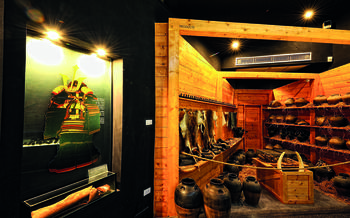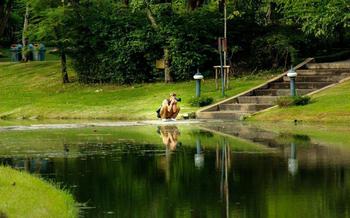
Shinto Park, The Park of Japanese Village
- Exploring the Japanese Village:
- Shinto Shrine and Torii Gates
- Japanese Garden and Pond:
- Bonsai and Ikebana Exhibitions
- Tea Ceremony Experience
- Kimono Rental and Dressing
- Japanese Crafts and Souvenirs
- Live Performances and Entertainment
- Japanese Cuisine and Restaurants
- Shopping for Japanese Goods
- Children's Activities and Playground
- Photography Opportunities
- Guided Tours and Workshops
- Insider Tip:
Exploring the Japanese Village:
Step into the meticulously designed Japanese Village, a charming replica of a traditional Japanese town. Wander through the cobblestone streets lined with authentic wooden houses and shops that have been carefully crafted to evoke the ambiance of old Japan. The village is adorned with lanterns, noren curtains, and intricate carvings, immersing you in the unique aesthetic of Japanese architecture.
Stroll past traditional Japanese houses with their distinctive sliding doors, tatami mats, and tokonoma alcoves. Discover specialty shops selling handmade crafts, souvenirs, and Japanese snacks. Indulge in the delectable flavors of authentic Japanese cuisine at the various restaurants, from freshly prepared sushi to steaming bowls of ramen.
As you explore the village, be sure to attend one of the cultural performances or events that are frequently held. Watch talented performers showcase traditional Japanese music, dance, and martial arts demonstrations. Immerse yourself in the vibrant atmosphere of seasonal festivals, such as the cherry blossom festival or the summer fireworks display. The Japanese Village is a living testament to the rich cultural heritage of Japan, offering an unforgettable journey through its history and traditions.
Shinto Shrine and Torii Gates
At the heart of the Japanese Village lies the sacred Shinto shrine, a place of worship and spiritual reverence. Its vermilion-lacquered pillars and intricate carvings exude an aura of tranquility and respect. The shrine is dedicated to the Shinto deity, Inari, known for bringing good fortune and prosperity.
The entrance to the shrine is marked by a majestic torii gate, a traditional Japanese archway that signifies the transition from the mundane world to the sacred realm. As you step beneath the torii gate, a sense of awe and reverence washes over you, preparing you for the spiritual journey that awaits.
Within the shrine, you'll find various offerings, such as sake, rice, and fruits, placed respectfully by devotees seeking blessings and guidance. The shrine's serene atmosphere invites you to pause and reflect, offering a unique opportunity to connect with the spiritual essence of Japanese culture.
If you're fortunate, you may witness traditional Shinto rituals and ceremonies performed by the shrine's caretaker. These ceremonies, often accompanied by the chanting of prayers and the ringing of bells, offer a glimpse into the deep-rooted traditions and beliefs of the Shinto faith.
Taking part in traditional Shinto practices, such as offering prayers or purchasing a sacred amulet, can be a profound and enriching experience. It allows you to immerse yourself in the spiritual customs of Japan and gain a deeper understanding of the country's rich cultural heritage.
Japanese Garden and Pond:
Surrounded by lush greenery and meticulously manicured landscapes, the Japanese Garden within Shinto Park exudes an aura of profound tranquility and serenity. Traditional elements such as stone lanterns, arched bridges, and winding paths create a harmonious blend of nature and human artistry. Visitors can lose themselves in the tranquil ambiance, taking a moment to appreciate the beauty of the surroundings and find solace amidst the serene atmosphere.
Koi fish, with their vibrant colors and graceful movements, swim gracefully in the crystal-clear pond, adding a touch of life and movement to the otherwise tranquil setting. The vibrant flora, with blooming flowers and verdant foliage, paints a tapestry of colors that delights the senses and creates a feast for the eyes. As you stroll along the garden paths, the gentle sound of water trickling from a nearby fountain or the chirping of birds in the trees heightens the sensory experience, immersing you fully in the tranquility of the Japanese Garden.
In this haven of peace and tranquility, visitors can find respite from the hustle and bustle of everyday life, embracing the serenity of the moment and allowing themselves to be enveloped by the beauty of nature and the serenity of the Japanese Garden. It's a place where time seems to slow down, inviting you to pause, reflect, and reconnect with your inner self, finding a sense of tranquility and peace that lingers long after your visit.
Bonsai and Ikebana Exhibitions
The Shinto Park in Kanchanaburi, Thailand, showcases the beauty and artistry of Japanese culture through its bonsai and ikebana exhibitions. Visitors can marvel at the intricate and miniature landscapes created by the skilled hands of bonsai masters. Demonstrations and workshops on bonsai care are also offered, providing insights into the ancient art of cultivating these miniature trees.
Additionally, the park features ikebana flower arrangements, which are a symbol of Japanese aesthetics and philosophy. These arrangements, often created with seasonal flowers and foliage, represent the harmony between nature and humanity. Visitors can learn about the symbolism and techniques of ikebana through interactive displays and demonstrations, gaining a deeper appreciation for this traditional Japanese art form.
Tea Ceremony Experience
Immerse yourself in the ancient Japanese tradition of the tea ceremony at the Shinto Park. Experience the tranquility and serenity of this ritual, where every movement and gesture holds cultural significance. Learn the etiquette and customs associated with the ceremony, from the proper way to greet your tea master to the art of whisking matcha tea. Savor the delicate flavors of matcha, accompanied by traditional Japanese sweets, as you embrace the Zen philosophy that lies at the heart of this sacred practice. Let the tea ceremony transport you to a realm of mindfulness and spiritual awakening, leaving you with a sense of peace and tranquility.
Kimono Rental and Dressing
At the Shinto Park, you can immerse yourself in the Japanese culture by trying on a traditional kimono. The park offers a variety of beautiful kimonos to choose from, ranging from vibrant colors to elegant patterns. The staff is friendly and helpful, and they will assist you with dressing in the kimono and choosing the perfect accessories. Once you're dressed, you can stroll through the Japanese village and take photos in the picturesque surroundings. You'll feel like a true Japanese local as you explore the park and interact with the other visitors. Remember to capture your special moments in photos to cherish the memory of your unique experience.
Japanese Crafts and Souvenirs
Strolling through the Japanese Village, visitors will encounter an array of shops and stalls showcasing traditional Japanese crafts and souvenirs. These unique items, meticulously handcrafted by local artisans, offer a glimpse into the rich cultural heritage of Japan. Visitors can peruse exquisite ceramic ware, intricate wood carvings, delicate glassware, and colorful textiles, each piece imbued with its own story and symbolism.
Ornately designed jewelry, featuring intricate patterns and precious gemstones, beckons to those seeking a touch of Japanese elegance. Hand-painted fans, with their vibrant hues and graceful designs, make for a perfect souvenir to cool off on a hot summer day or add a touch of Japan to one's home décor.
For those seeking a truly unique gift, custom-made calligraphy or ukiyo-e prints, capturing the essence of Japanese art and tradition, can be commissioned. These personalized keepsakes serve as a lasting reminder of one's visit to the Shinto Park.
Bargaining is an essential part of the shopping experience in Thailand. While prices are generally fixed in the park, visitors are encouraged to politely negotiate for a better deal, especially when purchasing multiple items. A friendly smile and a willingness to engage with the vendors can often lead to significant discounts.
Live Performances and Entertainment
Immerse yourself in the vibrant culture of Japan through captivating live performances and entertainment at the Shinto Park. Talented artists showcase traditional Japanese music and dance, including graceful geisha dances, energetic taiko drumming, and intricate martial arts demonstrations. These performances offer a glimpse into Japan's rich cultural heritage and provide an unforgettable experience for visitors of all ages.
Seasonal festivals and events add even more excitement to the park's offerings. During these special occasions, the park comes alive with vibrant decorations, lively music, and an array of cultural activities. From traditional Japanese folk games to tea ceremonies and calligraphy workshops, there's something for everyone to enjoy. These events provide an opportunity to delve deeper into Japanese culture, interact with locals, and create lasting memories.
Japanese Cuisine and Restaurants
While exploring the Shinto Park, you'll stumble upon authentic Japanese restaurants that offer a culinary journey to the land of the rising sun. Indulge in the flavors of freshly prepared sushi, savor the richness of ramen bowls, or delight in the simplicity of udon noodles. Each dish is meticulously crafted with traditional techniques and ingredients, ensuring a true taste of Japan.
For those with dietary restrictions, vegetarian and vegan options are also available, allowing everyone to enjoy the wonders of Japanese cuisine. Don't miss the chance to try matcha tea, a vibrant green tea with a distinct flavor, often served with traditional Japanese sweets. As you savor the delicate flavors of Japanese cuisine, you'll find yourself transported to the vibrant streets of Tokyo or the serene tea houses of Kyoto.
Shopping for Japanese Goods
While immersing yourself in Japanese culture at Shinto Park, don't miss the opportunity to shop for authentic Japanese goods. The park features a Japanese grocery store stocked with imported products, allowing you to bring a taste of Japan back home. From premium sake and green tea to traditional snacks and ingredients, you'll find a wide variety of items to choose from.
Beyond food, you can also find an array of Japanese cosmetics, skincare products, and fashion items. Known for their high quality and unique formulations, Japanese beauty products are a popular choice among visitors. You'll find everything from delicate cherry blossom-scented soaps to advanced anti-aging serums.
When selecting souvenirs for friends and family, consider traditional Japanese handicrafts such as ceramics, textiles, and lacquerware. These items showcase the exquisite craftsmanship and artistry of Japanese artisans. You can also find unique gifts like lucky charms, kokeshi dolls, and miniature replicas of Japanese landmarks.
Remember, shopping in Thailand offers the advantage of tax-free purchases. Take advantage of this opportunity to save on your souvenirs and indulge in some retail therapy while supporting local businesses and artisans.
Children's Activities and Playground
When traveling with kids, it's essential to keep them entertained and engaged. Shinto Park has a dedicated playground designed to cater to the needs of young visitors. Equipped with various traditional Japanese games and activities, this playground offers hours of fun and educational experiences for children.
In addition to the playground, kids can participate in a range of other activities to immerse themselves in Japanese culture. They can rent traditional kimonos and have their faces painted with intricate designs, transforming themselves into miniature Japanese locals. The park also organizes regular children's workshops, where kids can learn about Japanese customs, crafts, and traditions in a hands-on and interactive manner.
These activities not only provide entertainment for children but also serve as an excellent opportunity for them to learn about Japanese culture and history. By participating in these activities, kids can gain a deeper appreciation for the unique traditions and customs of Japan, creating lasting memories that will stay with them long after their visit.
Photography Opportunities
At Shinto Park, the picturesque moments are endless. The meticulously designed Japanese Village provides an array of backdrops that will transform your photos into travel memories worth cherishing. Capture the vibrant colors of the torii gates against the lush greenery or snap a serene shot of the koi pond, with its graceful koi fish swimming beneath the arched bridges. Take a stroll through the village and immortalize the traditional Japanese houses and shops, each with their unique charm. Don't miss the opportunity to document your visit in a kimono, posing gracefully amidst the authentic Japanese surroundings. Share your stunning captures on social media using hashtags like #ShintoPark, #Kanchanaburi, and #JapaneseVillage to inspire fellow travelers and showcase the beauty of this hidden gem.
Guided Tours and Workshops
Enhance your visit to Shinto Park by joining a guided tour or participating in one of the many workshops offered. Knowledgeable guides will lead you through the park, sharing insights into Japanese culture, history, and the significance of the various attractions. Guided tours are available in English and other languages, making it accessible to visitors from all over the world.
Workshops provide a hands-on experience, allowing you to learn about traditional Japanese arts and crafts. Try your hand at calligraphy, where you'll learn to write Japanese characters with a brush and ink. Create your own origami masterpiece, folding paper into intricate shapes inspired by nature. Participate in an ikebana workshop and discover the art of Japanese flower arrangement, learning the symbolism behind each flower and placement. These workshops not only provide a fun and interactive experience but also deepen your understanding and appreciation of Japanese culture.
Insider Tip:
-
Best Time to Visit: Aim for the shoulder seasons (April-May and September-October) to avoid peak tourist crowds and enjoy more pleasant weather conditions.
-
Secret Photo Spots: Venture off the beaten path to discover hidden corners of the park that offer unique photo opportunities. Try the serene bamboo forest, the tranquil koi pond, or the colorful torii gates against a backdrop of lush greenery.
-
Hidden Gems: Don't miss the tucked-away teahouse nestled amidst the gardens, where you can savor authentic matcha tea while immersing yourself in the tranquil ambiance.
-
Maximize Your Experience: Take advantage of the guided tours to gain deeper insights into Japanese culture and history. Participate in hands-on workshops to learn traditional crafts like calligraphy or origami, enriching your understanding and appreciation of Japanese art and traditions.



